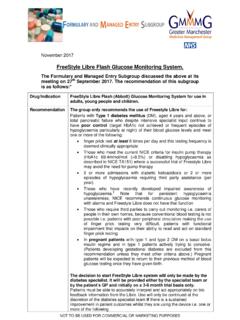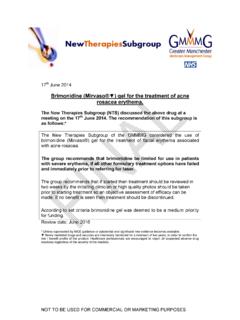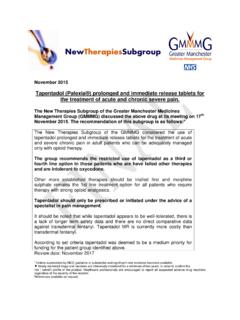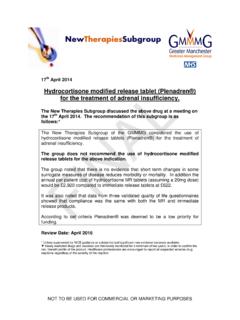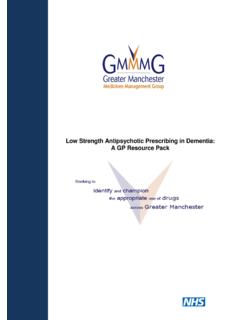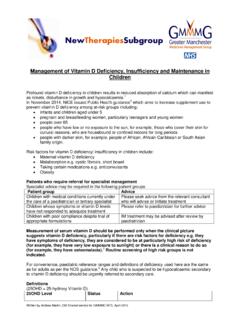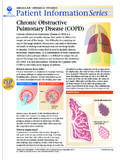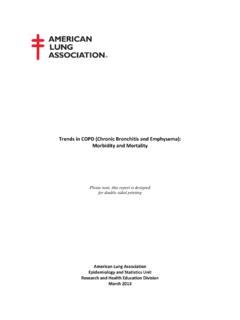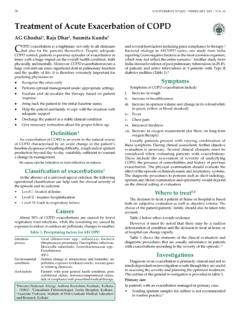Transcription of Non-pharmacological management for ALL patients
1 Greater Manchester copd management Plan Non-pharmacological management for ALL patients Smoking Cessation Annual Flu Vaccination Pulmonary Rehabilitation Increase daily activity Inhaler Technique Measure O2 Saturation Self- management Advanced Care Address Co- Plan Planning morbidities 1. The below Non-pharmacological management steps can provide important health benefits smoking cessation reduces disease progression, pulmonary rehabilitation improves quality of life, increasing activity levels improves prognosis. Smoking Cessation: Utilise every contact to offer brief interventions for smoking cessation (Training available at: ). Refer onto to smoking cessation services locally for all patients in agreement Vaccinations Annual flu vaccination A single dose of pneumococcal vaccine PPV23 should be administered Pulmonary rehabilitation: patients should be referred if they have exercise limitation due to breathlessness (NICE.)
2 Quality Standard, 2016). This is usually MRC 3 or greater (or mMRC 2). Main contraindications include uncontrolled cardiovascular disease, significant balance/gait disorders and significant cognitive impairment. Resource: Video clip showing patients participating in and talking about their experience of pulmonary rehabilitation. All patients should aim to increase activity levels, with or without pulmonary rehabilitation. Increase daily activity patients should be advised of simple ways to improve functional activity to improve breathlessness and reduce the cycle of deconditioning. BLF Exercise Plan: Inhaler technique: This should be reviewed regularly and always before increasing treatment. It is not always possible to utilise same device for all treatments but you should aim to use the same type MDI/Aerosol or Dry powder devices Good Practice Points: Add a spacer device for use with MDI.
3 Instruction for inhaling via a MDI should be gentle and deep . Instruction for inhaling via a DPI should be forceful and deep . Resource: educational podcasts which show correct technique for each device are available at Common errors: MDI: Not shaking the device before use, poor co-ordination and inhaling too quickly. Dry powder inhalers (DPI): Inhaling too slowly and priming/positioning errors. 2. Oxygen referral: patients with a persistent, resting, stable SpO2 of 92% should be referred for home oxygen assessment. copd treatment should be optimised prior to referral. Consider referral for patients with SpO2 of 94% where there is evidence of polycythaemia (haematocrit 55% in males or 47% in females), peripheral oedema or pulmonary hypertension. Self- management Plan & Rescue Pack: A self- management plan should be given to all patients . Rescue packs are suitable for some patients patients who are able to identify own symptoms of an exacerbation and act promptly, patients who are unlikely to overuse with repeated courses of steroids, patients who have had proper education on self- management etc.
4 patients should be reviewed within a reasonable timescale in relation to using their rescue pack. Find out whether they took it appropriately and whether it made any difference. Rescue packs are not normally suitable for prescribing as repeat medication. Consider and treat co-morbid disease Consider screening for anxiety and depression (for example using PHQ-9 & GAD-7). Cognitive behavioural therapy can be useful. Consider screening for osteoporosis and for heart failure. Advance care planning and end of life care Consider conversations about advance care planning and end of life care with referral to specialist teams as appropriate. Ensure these patients are on the Gold Standards Framework register as appropriate. Refer to local palliative care guidance. Exacerbation a copd worsening requiring oral corticosteroids and / or antibiotics 3. Pharmacological treatment pathway for patients with copd .
5 Note: Inhalers should be prescribed by Brand Name SABAa Airomir / Ventolin (salbutamol) cfc free MDI or DPI OR Bricanyl (terbutaline) DPI. FEV1 <50% predicted and 1 hospitalisation Still symptomatic OR 2 exacerbations in 1 year Add LAMA. Dry Powder inhaler: Seebri Breezhaler . (glycopyrronium). Metered dose inhaler (soft mist): Spiriva Respimat (tiotropium). Add ICS/LABA. 1 hospitalisation within 1 year OR Dry Powder inhaler: Relvar Ellipta . 92mcg/22mcg (fluticasone/vilanterol). 2 exacerbations within 1 year OR. Breathlessness requiring treatment* Metered dose inhaler: Fostair MDI. 100mcg/6mcg (beclometasone/formoterol). Switch to single inhaler LAMA/LABA combination .. Step up from Seebri Breezhaler (glycopyrronium DPI) to . Ultibro Breezhaler (glycopyrronium/indacaterol DPI).. Step up from Spiriva Respimat (tiotropium SMI) to . Spiolto Respimat (olodaterol/tiotropium SMI). Breathlessness requiring Further exacerbations Add LAMA if further exacerbations or treatment* or hospital breathlessness requiring treatment*.
6 Admission**. Reinforce non- Triple therapy: ICS/LABA/LAMA.. pharmacological Trelegy Ellipta (fluticasone/ umeclidinium/ vilanterol 92 mcg/55 mcg/22 mcg). management .. Trimbow MDI (Beclometasone/ formoterol /glycopyrronium MDI 87mcg/5mcg/9mcg). * MRC Dyspnoea scale 3 or mMRC 2 or CAT >=10 can be used to measure dyspnoea level for step-up treatment 4. ** Escalate to triple therapy ONLY when these criteria are met Overview Efficacy and safety were the primary considerations in the selection of the first choice recommendations stated in the pathway. We have offered one DPI and one MDI choice at each step; it is important to select a device that patients can use properly. Further options are listed below. The first choice and alternative options are cost- effective treatments. The first choice initial LAMA is guided by a preference to use glycopyrronium/indacaterol if step up is required. This recommendation has been made based on the large body of clinical evidence supporting the effects of glycopyrronium/indacaterol on relevant clinical outcomes including symptoms and exacerbations.
7 Alternative choices based on a preference for a different inhaler device, or twice a day dosing are listed below. For patients who are intolerant to a LAMA, try a LABA; indacaterol (Onbrez Breezhaler ). is preferred. Footnotes a patients intolerant of a SABA may be initiated on a short or long-acting antimuscarinic [SAMA. or LAMA]. Other treatment options LAMA: Incruse Ellipta (umeclidinium); Step up to Anoro (umeclidinium / vilanterol). Triple therapy: Trelegy Ellipta (Fluticasone /umeclidinium / vilanterol DPI). LAMA: Eklira Genuair (twice daily) DPI (aclidinium ); Step up to Duaklir Genuair (formoterol/aclidinium ) DPI. Triple therapy: Eklira Genuair (aclidinium) + Fostair NEXT haler 100/6. (beclometasone/formoterol) DPI. Alcohol Airsalb, Fostair and Trimbow metered dose inhalers contain ethanol which may be an important issue to some patients . Roflumilast This is an option to add onto triple therapy as per the criteria stated in NICE TA 461 and should only be started by a specialist in respiratory medicine.
8 5. Treatment of new copd patients FEV1. Spirometry (measuring FEV1 and FVC) is needed to make the diagnosis of copd . FEV1 can be used to measure worsening or improvement in patients . However, the majority of treatment decisions regarding bronchodilators and ICS should be based on symptoms and exacerbations, not FEV1. Stepwise approach to treatment Most patients can be treated with a stepwise escalation of pharmacotherapy, adding in one extra drug at a time (not two). This has the advantage of being able to assess the response to each drug, and preventing overtreatment. In general, a threshold of 2 or more exacerbations or one hospitalisation in the last year can be used to step up treatment Initial copd treatment Newly diagnosed copd patients should be treated with a SABA initially. The next step (if needed) should be the addition of a LAMA; these drugs improve symptoms and reduce exacerbations.
9 The only exception is patients with FEV1<50% and 2 exacerbations who may start on ICS / LABA immediately. Dual Bronchodilator Combinations patients who are breathless or suffering with exacerbations, despite treatment with a LAMA can be stepped up to receive a combination inhaler containing a LABA + LAMA. These combination inhalers reduce symptoms and exacerbations. 6. patients already established on inhaled medicines; Treatment optimisation Many patients are currently receiving inhaled medicines that differ to those recommended in the copd pharmacological treatment pathway. Treatment of these patients should be changed to receive the equivalent inhalers in the pathway. Examples of potential optimising inhaler changes are provided below. Advantages for this are: 1. Optimising inhaler device 2. Patient's convenience 3. Cost Optimisation should be managed closely by a healthcare professional, and the technique of the new inhaler device(s) should be taught.
10 patients who deteriorate after changing inhalers should be placed on alternatives stated in the pathway. Optimising inhaled treatment examples Previous treatment Recommended new treatment Seretide 250/25 MDI Fostair 100/6 MDI. Seretide 500/50 DPI Relvar 92/22 DPI or Fostair NEXT haler 100/6. Tiotropium Handihaler monotherapy Seebri Breezhaler DPI (glycopyrronium) or Spiriva (tiotropium) Respimat*. Seretide 250/25 MDI plus tiotropium Trimbow (beclometasone/ formoterol handihaler /glycopyrronium MDI 87mcg/5mcg/9mcg). Seretide 500/50 DPI plus tiotropium Trelegy Ellipta (Fluticasone /umeclidinium /. handihaler vilanterol 92mcg/55mcg/22mcg). Symbicort 200/6 or 400/12 Turbohaler plus Trelegy Ellipta (Fluticasone /umeclidinium /. tiotropium Handihaler vilanterol 92mcg/55mcg/22mcg). * The choice of drug should be influenced by which inhaler device the patient has received training in the use of and can demonstrate satisfactory technique (NICE).


